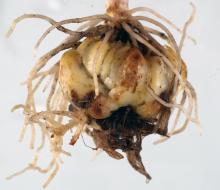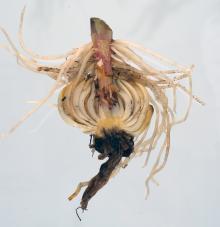See:
Lily (Lilium spp.) - Root Rots
Cause Fusarium oxysporum f. sp. lilii, a fungus. The fungus is carried on bulbs and can survive in soil indefinitely. The disease usually comes into a planting on infected lily bulbs. If a lily plant yellows during the current season, the usual cause is Fusarium bulb rot. Initial infection occurs just behind the root cap. Conidia germinate within 6 hours and within 48 hours spread through the intercellular spaces between the epidermis and the outermost cells of the root cortex. Direction infection of scales may also occur through stomata in the epidermis. Unlike other many other Fusarium diseases this is not a vascular wilt but a rot of the cortical tissues of the root. Fusarium bulb rots are more common during the winter when soils can be excessively wet. The disease also occurs often as a combination with Cylindrocarpon, other Fusarium spp. and other fungi.
Symptoms This disease results in a severe root rot and destruction of the basal plate. Chocolate or bluish-gray rot that extends from the basal plate into the scales. The surface of rotting scales remains smooth until disintegration begins. Scales detach at the basal plate, and bulbs often fall to pieces after digging. Aboveground symptoms are general to many belowground diseases and include premature yellowing of the foliage, stunting, and premature senescence. Flower buds may wilt and fail to open.
Cultural control
- Destroy bulbs with chocolate-color rot at base of scales.
- Propagate from rot-free scales.
- If disease is in a lily bed, dig bulbs and destroy all rotted ones.
- Improve soil drainage.
- Use low-nitrogen fertilizers.
- Remove remnants of bulbs and plant debris.
- The Asiatic lilies 'Connecticut King' and 'Mont Blanc' have shown resistance when grown in the field in the Netherlands.
Chemical control Soaking clean sorted bulbs prior to planting has helped prevent the disease.
- 42-S Thiram at 1.5 pints/8 gal water. Group M3 fungicide. 24-hr reentry.
- Daconil Ultrex at 2.5 to 5 lb/100 gal water. Soak bulbs for 15 min. before planting. Group M5 fungicide. 12-hr reentry.
- KleenGrow at 0.15 to 1.5 fl oz/gal water. Soak for 30 seconds and allow to drain.
- Medallion WDG at 8 oz/100 gal water. Soak sorted bulbs for 20 min then dry. Group 12 fungicide. 12-hr reentry.
- Mertect 340 F at 30 oz/100 gal water at 55°F to 75°F. Soak bulbs 15 to 30 min. within 48 hours after digging, then let dry. Group 1 fungicide.12-hr reentry.
- Postiva at 10 to 28 fl oz/100 gal water as a pot drench. Group 3 + 7 fungicide. 12-hr reentry.
- Thiophanate-methyl-based products as a postharvest soak at 80°F to 85°F. Soak clean bulbs 15 to 30 min. within 48 hours after digging. Group 1 fungicides. 12-hr reentry.
- Bonide Infuse Systemic Disease Control Lawn and Landscape at 3 lb/1,000 sq ft. Activate with 0.1 to 0.25 inches water within 24 hours after application. H
- Cleary's 3336 EG at 16 to 24 oz/100 gal water.
- OHP 6672 4.5 F at 16 to 20 fl oz/100 gal water.
- Systec 1998 at 33 fl oz/100 gal water. Washington only.
Note: Disinfectants such as quaternary ammonium compounds and chloride dioxide do not provide the same residual control as traditional fungicides.
Biological control Use in conjunction with other control tactics such as thorough sanitation.
- Actinovate AG (Streptomyces lydicus strain WYEC 108) at 3 to 12 oz/A. 4-hr reentry. O
Reference Baayen, R.P. and Rijkenberg, F.H.J. 1999. Fine structure of the early interaction of lily roots with Fusarium oxysporum f. sp. lilii. European Journal of Plant Pathology 105:431-443.



